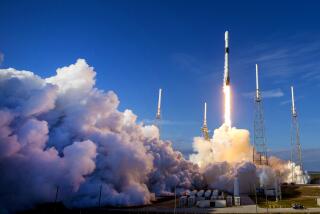Release of Spy Satellite Expected : NASA Dishes Up Menu, No News on Atlantis’ Day
- Share via
HOUSTON — The National Aeronautics and Space Administration disclosed nothing but the lunch menu Saturday, the day the space shuttle Atlantis was to deploy a top-secret spy satellite that can peer down at the Soviets through clouds and darkness.
The public space-to-ground radio link was silent while the crew of five military men went about their business on the second day of the mission, which began with Friday’s launch and is under the control of the Air Force.
NASA said in advance that it would break the silence only if major problems developed.
By all accounts, Saturday was to have been the crew’s busiest day, with the expected release of the $500-million Lacrosse satellite, but the only official word on the mission came from NASA, which released the menu: salmon, ham, macaroni and cheese and turkey Tetrazzini.
To Be ‘Radar Eye’
Sources have said the satellite is capable of recording sharp images of military targets in the Soviet Bloc. Weighing 18 tons and with a solar panel that stretches 150 feet, the satellite, sources say, will help verify Soviet compliance with arms treaties and serve as a “radar eye” for the stealth bomber.
The Soviet news agency Tass has told about many details of the satellite, including the code name Lacrosse.
Only military men are aboard Atlantis, serving under Navy Cmdr. Robert L. (Hoot) Gibson, the commander. The pilot is Air Force Lt. Col. Guy S. Gardner, and the mission specialists are Col. Richard M. Mullane and Lt. Col. Jerry L. Ross of the Air Force and Navy Cmdr. William M. Shepherd.
At the Kennedy Space Center in Florida, officials said Saturday that Atlantis’ high-power main engines worked properly during the spaceship’s climb to orbit Friday, despite the failure of a critical temperature sensor halfway to orbit.
About 4 1/2 minutes after blastoff, a critical temperature sensor in Atlantis’ main engine No. 3 failed, causing ground controllers a moment of anxiety: Had a second sensor failed shortly thereafter, the ship’s crew could have faced an abort. But the second sensor worked properly.
Boosters Towed to Port
The shuttle’s burned-out solid-fuel boosters were towed into Port Canaveral on Saturday for a detailed inspection to find out how redesigned O-ring seals worked during the second post-Challenger shuttle launch.
It was an O-ring booster failure that doomed Challenger, and although redesigned seals worked perfectly in the first post-Challenger flight Sept. 29, engineers anxiously awaited Atlantis’ rockets to confirm the performance of the new joint design.
A visual inspection showed what appeared to be normal charring around the nozzles.
Meanwhile, NASA announced Saturday that a satellite rocket stage being readied for the next shuttle launch in February was damaged by a worker and will have to be replaced.
NASA spokesman George Diller said officials are assessing “what impact if any this incident might have on the planned Feb. 18 launch.”
The stage is needed to boost a communications satellite to a high orbit once the astronauts have released it from Discovery’s cargo bay. Diller said the worker bumped into the first stage nozzle and cracked it during prelaunch checks Thursday.
More to Read
Sign up for Essential California
The most important California stories and recommendations in your inbox every morning.
You may occasionally receive promotional content from the Los Angeles Times.










